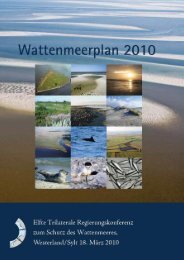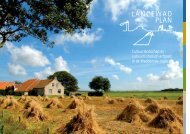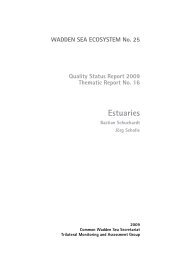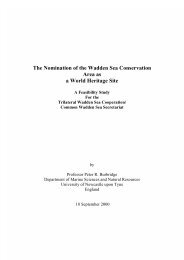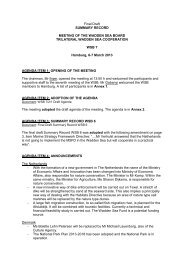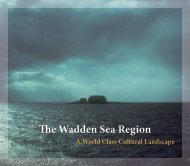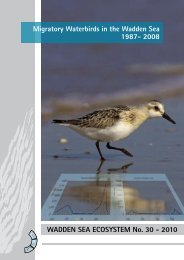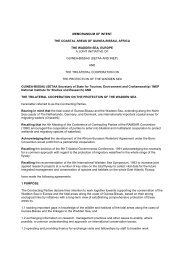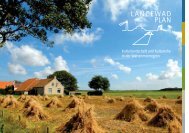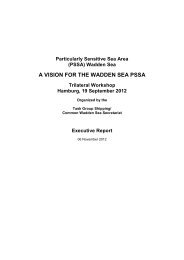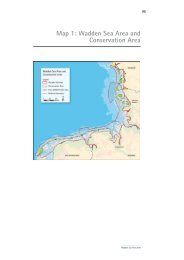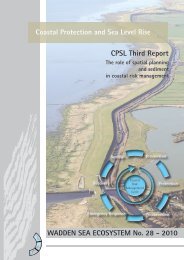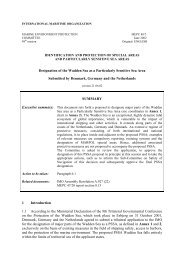8.3 Intertidal Blue Mussel Beds - Trilateral Wadden Sea Cooperation
8.3 Intertidal Blue Mussel Beds - Trilateral Wadden Sea Cooperation
8.3 Intertidal Blue Mussel Beds - Trilateral Wadden Sea Cooperation
Create successful ePaper yourself
Turn your PDF publications into a flip-book with our unique Google optimized e-Paper software.
190<br />
<strong>8.3</strong> <strong>Intertidal</strong> <strong>Blue</strong> <strong>Mussel</strong> <strong>Beds</strong><br />
Jaap de Vlas<br />
Bert Brinkman<br />
Christian Buschbaum<br />
Norbert Dankers<br />
Marc Herlyn<br />
Per Sand Kristensen<br />
Gerald Millat<br />
Georg Nehls<br />
Maarten Ruth<br />
Josien Steenbergen<br />
Achim Wehrman<br />
<strong>Blue</strong> mussel bed<br />
(Photo: G. Millat)<br />
<strong>8.3</strong>.1 Introduction<br />
<strong>Beds</strong> of the blue mussel (Mytilus edulis) are important<br />
biogenic structures in the <strong>Wadden</strong> <strong>Sea</strong><br />
ecosystem, serving as habitat and as food source<br />
for a number of species. In the <strong>Wadden</strong> <strong>Sea</strong> Plan<br />
(1997), a specific trilateral Target was formulated<br />
aiming for an increase of the total area and a more<br />
natural development and distribution of natural<br />
intertidal mussel beds, providing a framework for<br />
habitat management.<br />
Targets<br />
• A natural dynamic situation in the Tidal Area.<br />
• An increased area of geomorphologically and<br />
biologically undisturbed tidal flats and subtidal<br />
areas.<br />
• An increased area of, and a more natural distribution<br />
and development of natural mussel<br />
beds, Sabellaria reefs and Zostera fields.<br />
To protect intertidal mussel beds, in all three<br />
countries considerable parts of the intertidal area<br />
have been permanently closed for blue mussel fishing,<br />
but differences between countries are substantial.<br />
In The Netherlands, fishery is restricted<br />
to young, unstable beds outside areas that are<br />
permanently closed. In Niedersachsen, fishery of<br />
seed mussels is allowed in significant parts of the<br />
intertidal, in accordance with a management plan.<br />
In Schleswig-Holstein, mussel fishery is not allowed<br />
in the intertidal area, as well as, in most<br />
subtidal parts of the national park core zone. In<br />
Denmark, mussel fishery is allowed on a small<br />
scale, in intertidal as well subtidal areas, but the<br />
quotas since 1992 have been fished in subtidal<br />
areas only. A comprehensive overview of mussel<br />
fishing policies was drawn up by the Common<br />
<strong>Wadden</strong> <strong>Sea</strong> Secretariat (CWSS, 2002a) (see chapter<br />
2.5).<br />
The Governmental Conference in Esbjerg (2001)<br />
acknowledged ‘the efforts that have been made<br />
with regard to the policy on the mussel fishery’<br />
and stressed ‘that the implementation of the Targets<br />
on geomorphology, eelgrass beds and mussel<br />
beds still deserves attention and, therefore decided<br />
‘to evaluate before the end of 2004 the mussel<br />
fishery with special attention to stable mussel<br />
beds’ (§9 Esbjerg Declaration) and ‘to base the<br />
conservation and management of mussel beds on<br />
the protection of sites where stable beds occur<br />
and areas with a high potential for the development<br />
of stable mussel beds’ (§10 Esbjerg Declaration).<br />
The 1999 QSR focused on a description of the<br />
long-term development of intertidal mussel beds<br />
up to 1997. In the 1980s and 1990s, the area of<br />
beds and biomass were lower than before 1980.<br />
Therefore, it was concluded that the Target of an<br />
increased area and a more natural development<br />
of natural intertidal mussel beds had not been<br />
reached. In fact, the number and size of mature<br />
blue mussel beds had declined in the last decade.<br />
Several factors relevant for survival of mussel<br />
beds were discussed. It was doubted whether an<br />
increase in storminess (as observed in some parts<br />
<strong>Wadden</strong> <strong>Sea</strong> Ecosystem No. 19 - 2005
<strong>8.3</strong> <strong>Intertidal</strong> <strong>Blue</strong> <strong>Mussel</strong> <strong>Beds</strong><br />
191<br />
of the <strong>Wadden</strong> <strong>Sea</strong> during the last decade) or icescouring<br />
(no significant differences with the longterm<br />
average) had been the main factors of the<br />
observed long-term decline. Fisheries, on the other<br />
hand, had caused large declines and prevented<br />
recovery, especially in periods of failing spatfall.<br />
Therefore, it was proposed that the management<br />
of mussel fishery should be based on protection<br />
of sites where stable beds occur and of sites with<br />
a high potential for the development of stable<br />
beds.<br />
The following paragraphs report on the implementation<br />
of the recommendations in the 1999<br />
QSR, the developments of the mussel beds and<br />
mussel stocks since 1999, the impact of mussel<br />
fishery, and the role of bio-invaders in mussel beds.<br />
<strong>8.3</strong>.2 Implementation of 1999<br />
recommendations<br />
<strong>8.3</strong>.2.1 A protocol for harmonized<br />
description and area measurement<br />
of mussel beds<br />
In 2002, a common trilateral definition of a mussel<br />
bed was developed (CWSS, 2002b; Herlyn,<br />
2005). This definition is based on the structure of<br />
mussel beds:<br />
‘A mussel bed is a benthic community structured<br />
by blue mussels. It may consist of a spatially<br />
well-defined irregular collection of more or less<br />
protruding smaller beds, which may be called<br />
patches, separated by open spaces. This description<br />
also includes young beds with a high abundance<br />
of small mussels. The described structure<br />
may not be so distinct in young beds or just settled<br />
beds (spatfall).’<br />
In the field, boundaries between a mussel bed<br />
and the surrounding intertidal flat are not always<br />
clear-cut, which can easily lead to differences in<br />
size estimates among individual observers. Moreover,<br />
in the field, transition zones between mussel<br />
beds and the surrounding tidal flat do occur.<br />
The following criteria were developed in order to<br />
make standardized decisions on the boundaries<br />
of mussel beds when carrying out field surveys<br />
(see also Figure <strong>8.3</strong>.1): A group of mussel patches<br />
less than 25 meters apart is considered as a bed,<br />
but only if at least 5% of the sea bottom is covered<br />
by these patches; the coverage of the area<br />
with mussel patches is >5% if the space between<br />
them is (on average) less than about four times<br />
the patch diameter. These criteria have been used<br />
since 2002.<br />
Fields of scattered mussels are not included in<br />
the definition of mussel beds and consequently<br />
they are not included in the quality status judgement.<br />
These fields consist of individual and small<br />
conglomerates of mussels, often with some cockle<br />
shells attached to their byssus threads. They can<br />
originate from spatfall or from mussel beds that<br />
have been damaged by storms and can be transported<br />
over tens, hundreds or even thousands of<br />
meters. They are generally not able to form a sizeable<br />
biogenic structure, but fields of scattered<br />
mussel clumps may consolidate to mussel beds<br />
by spatfall or by more mussels being transported<br />
from other intertidal or subtidal locations to these<br />
areas. However, most scattered mussel clumps disappear<br />
within one or two years. That does not<br />
alter the fact that they may form an important<br />
food source for oystercatchers and gulls.<br />
Aerial photographs and ground-surveys are<br />
used to determine the location, size and shape of<br />
mussel beds. For recognition of intertidal mussel<br />
beds on aerial photographs a stereoscope should<br />
be used. For monitoring purposes, it is important<br />
to carry out photographic surveys in a well-defined<br />
period of the year, because the surface covered<br />
by mussel beds can increase through spatfall<br />
during the summer months and will often decrease<br />
during autumn and winter due to storms<br />
and/or ice-scour. A relatively stable period is between<br />
March and July, after the winter and before<br />
new recruits can be detected on aerial photographs.<br />
Most of the maps of Dijkema (1989)<br />
were drawn from aerial photographs from this<br />
period. In The Netherlands (Ens et al., 2004) and<br />
Niedersachsen (Herlyn and Millat, 2004), this period<br />
is recommended for aerial surveys of the sur-<br />
Bed A<br />
192<br />
<strong>8.3</strong> <strong>Intertidal</strong> <strong>Blue</strong> <strong>Mussel</strong> <strong>Beds</strong><br />
face covered with mussel beds. In Schleswig-Holstein<br />
aerial photographs are intentionally made<br />
in autumn and therefore potentially include new<br />
spatfall of the year.<br />
<strong>8.3</strong>.2.2 The protection of young<br />
mussel beds<br />
In general, only limited research has been done<br />
on how and where young mussel beds could be<br />
best protected.<br />
In The Netherlands, habitat modeling was used<br />
to predict the stability of newly formed mussel<br />
beds in the intertidal (Brinkman and Bult, 2002).<br />
In areas with a high potential for stable mussel<br />
beds according to the habitat model, relatively<br />
more newly formed mussel beds appeared than in<br />
other areas, indicating the usefulness of this habitat<br />
modeling approach. Since 1995, all mussel<br />
beds in these ‘high potential’ areas have been protected.<br />
An index was developed for judging the<br />
expected stability of present beds, taking into account<br />
parameters such as sediment stability, and<br />
density and age composition of the mussels in the<br />
bed (Brinkman et al., 2003).<br />
In Niedersachsen, all the sites of mussel beds<br />
recorded during the last 50 years were documented<br />
Definitions<br />
<strong>Mussel</strong> bed<br />
A mussel bed is a benthic community structured by blue<br />
mussels. It may consist of a spatially well defined irregular<br />
collection of more or less protruding smaller beds, which<br />
may be called patches, separated by open spaces. This description<br />
also includes young beds with a high abundance of<br />
small mussels. The described structure may not be so distinct<br />
in young beds or just settled beds (spatfall) (<strong>Blue</strong> mussel<br />
workshop, 2002).<br />
Stable bed<br />
Bed where the structure (patches, formed relief) is clearly<br />
recognizable over many years (<strong>Blue</strong> mussel workshop 2003,<br />
QSR 1999).<br />
Stable site<br />
Location where mature mussel beds (one or more) occur regularly<br />
over several years (<strong>Blue</strong> mussel workshop 2002).<br />
Assessment criteria for persistence of a<br />
mussel bed<br />
Age of bed, type of location, sediment structure of mussel<br />
bed basis (<strong>Blue</strong> mussel workshop 2002).<br />
Larvae settlement<br />
The first benthic migrating stage of blue mussel larvae smaller<br />
than 1 mm is defined as primary settlement. The larvae can<br />
settle several times on various substrates until they get larger<br />
and settle more permanently on structures such as existing<br />
mussel beds or stones (secondary settlement) (<strong>Blue</strong> mussel<br />
workshop, 2000).<br />
Spatfall<br />
Settlement of young mussels on a tidal flat. These small<br />
mussels are called ‘spat’ during the year of settlement only.<br />
Recruitment<br />
The addition of young mussels to the reproducing population.<br />
For blue mussels, the concept of recruitment is used<br />
for young mussels which survived the winter (age = 1 year).<br />
in 1996 (Millat and Herlyn, 1999). The number<br />
amounted to 187 sites, of which 31 were protected<br />
by the National Park Law. From 1999 to<br />
2003 17 additional sites were closed for fishery<br />
according to the ‘Miesmuschelmanagementplan’.<br />
Additional data sets since then demonstrate that<br />
most of the blue mussel sites have shown a continuous<br />
occurrence of mussel beds. After an intensive<br />
revision in 2003, 102 sites were considered<br />
as locations where stable beds can occur (so<br />
called stable sites) (Herlyn and Millat, 2004). Under<br />
the new blue mussel fishery management plan<br />
(2004-2008), 17 out of these 102 sites are protected<br />
in addition to the 12 sites in areas closed<br />
for mussel fishery by the National Park Law.<br />
In Schleswig-Holstein, all intertidal mussel<br />
beds, existing as well as new ones, have been protected<br />
since 1996.<br />
In Denmark, some fishery was allowed until<br />
2003. It was only allowed to take a part of the<br />
expected production of the standing stock each<br />
year. This approach is intended to keep the standing<br />
stock at a stable level over the years. If, for<br />
one reason or another, the standing stock falls to<br />
a lower level, the production will also decrease.<br />
The share to be reserved for the birds, however,<br />
will remain the same and the fishery will be given<br />
a lower quota for the following season (Kristensen,<br />
1997, 2003; Munch-Petersen and Kristensen,<br />
2001). During the last 15 years, annually 10,000–<br />
15,000 t of mussels have been protected to serve<br />
as food for birds, leaving 3,000–10,000 t for fishery.<br />
In Denmark, the mussel fishery is restricted to<br />
harvesting of mussels of marketable size. The Danish<br />
regulations do not discriminate between intertidal<br />
and subtidal beds. This has been the precept<br />
since the beginning of the 1980s. Since 1992,<br />
mussel fishery has been allowed only in approx.<br />
50% of the Danish <strong>Wadden</strong> <strong>Sea</strong>, the main fishing<br />
area being Ho Bugt and northern part of Lister<br />
Deep. These areas contain intertidal as well as<br />
subtidal beds, the latter being preferred by the<br />
fishermen. As a consequence, the intertidal beds<br />
in the Danish <strong>Wadden</strong> <strong>Sea</strong> have not been fished<br />
since 1992.<br />
<strong>8.3</strong>.3 Development of area, biomass<br />
and age composition since 1999<br />
<strong>8.3</strong>.3.1 The Netherlands<br />
In their evaluation of the historical development<br />
of intertidal mussel beds, Dankers et al. (2003)<br />
re-estimated the area of mussel beds in the period<br />
1960–1990. This area may have varied between<br />
1,000 and 6,000 ha. The value of 4,120 ha for<br />
<strong>Wadden</strong> <strong>Sea</strong> Ecosystem No. 19 - 2005
<strong>8.3</strong> <strong>Intertidal</strong> <strong>Blue</strong> <strong>Mussel</strong> <strong>Beds</strong><br />
193<br />
area (ha)<br />
6,000<br />
5,000<br />
4,000<br />
3,000<br />
2,000<br />
1,000<br />
0<br />
spring<br />
autumn<br />
1991 1992 1993 1994 1995 1996 1997 1998 1999 2000 2001 2002 2003 2004<br />
Figure <strong>8.3</strong>.2:<br />
Surface area (ha) of<br />
intertidal mussel beds in the<br />
Dutch <strong>Wadden</strong> <strong>Sea</strong> since<br />
1994. Data is achieved<br />
during a ground survey and<br />
reconstructed afterwards<br />
(Steenbergen et al., 2003b).<br />
An update of the<br />
reconstruction was made in<br />
November 2004, and thus<br />
the data shown can be<br />
slightly different from data<br />
in Steenbergen et al.<br />
(2003b).<br />
1976 and 1978, presented in the 1999 QSR and<br />
well documented in the habitat maps for the <strong>Wadden</strong><br />
<strong>Sea</strong> (Dijkema, 1989), lies well within this range.<br />
These mussel bed areas occurred in spite of fishery,<br />
so these estimates can be considered as minimum<br />
values of the ‘natural’ area.<br />
Dankers et al. (2003) and van Stralen (2002)<br />
described the dynamics of the Dutch intertidal<br />
mussel beds. They stated that in most years some<br />
spatfall occurs in existing beds. Losses due to<br />
storms and ice winters are often compensated by<br />
good spatfall outside the remaining beds, but<br />
mostly in the neighborhood of or on the remainders<br />
of these.<br />
Most intertidal mussel beds in the Dutch <strong>Wadden</strong><br />
<strong>Sea</strong> disappeared in the period 1988-1991,<br />
after intensive fishery in a period with low spatfall<br />
(Dankers et al., 1999). The oldest intertidal beds<br />
now present in The Netherlands, with a total surface<br />
of about 200 ha (Dankers et al., 2003), are<br />
from the 1994 spatfall. The spatfalls of 1999, 2001<br />
and 2003 are the main contributors to the present<br />
situation. Based on ground survey and expert<br />
judgement the area of intertidal mussel beds in<br />
the spring of 2004 was estimated at about 2,200<br />
ha (Steenbergen et al., 2004).<br />
An overview of the development since 1994 of<br />
areas covered with mussel beds in spring and autumn<br />
in the Dutch <strong>Wadden</strong> <strong>Sea</strong> is given in Figure<br />
<strong>8.3</strong>.2. These areas are based on ground surveys, as<br />
well as a reconstruction of the data in areas that<br />
could not be included in the data surveyed completely<br />
due to shortage of time, mainly in autumn<br />
(Steenbergen et al., 2003a, 2003b). In the reconstruction,<br />
data for mussel bed-areas of all years<br />
was used in order to compensate for the missing<br />
data in the ground surveys. Data of autumn 2003<br />
and spring 2004 can only be reconstructed after<br />
the ground survey in spring 2005.<br />
The total biomass of mussels in the intertidal<br />
(scattered mussels and mussel beds) is monitored<br />
in spring. It has increased from about 11,000 t fresh<br />
weight in 1999 to about 74,000 t in 2004 (Steenbergen<br />
et al., 2004; Figure <strong>8.3</strong>.3).<br />
Since 1991, mussel fishery was restricted to the<br />
subtidal part of the Dutch <strong>Wadden</strong> <strong>Sea</strong>, with, however,<br />
two exceptions. First, some fishery was allowed<br />
in the autumn of 1994 on young seed beds<br />
of the 1994 spatfall. Most of these seed beds (both<br />
fished and unfished) disappeared in early 1995 due<br />
to storms. Second, a restricted experimental fishery<br />
was carried out in 2001 on beds that were<br />
considered unstable, to test the hypothesis that<br />
moderate fishery could increase the stability of<br />
fresh weight (tons)<br />
80,000<br />
70,000<br />
60,000<br />
50,000<br />
40,000<br />
30,000<br />
20,000<br />
Figure <strong>8.3</strong>.3:<br />
Total biomass (t fresh<br />
weight in spring) of<br />
intertidal blue mussels in<br />
the Dutch <strong>Wadden</strong> <strong>Sea</strong><br />
since 1999 (from:<br />
Steenbergen et al., 2004).<br />
10,000<br />
0<br />
1991 1992 1993 1994 1995 1996 1997 1998 1999 2000 2001 2002 2003 2004<br />
<strong>Wadden</strong> <strong>Sea</strong> Ecosystem No. 19 - 2005
194<br />
<strong>8.3</strong> <strong>Intertidal</strong> <strong>Blue</strong> <strong>Mussel</strong> <strong>Beds</strong><br />
Figure <strong>8.3</strong>.4:<br />
Development of the total<br />
surface area of intertidal<br />
blue mussel beds (ha) in<br />
Niedersachsen based on<br />
yearly spring surveys.<br />
(*1991: refers to the<br />
period of 1989-91) (from:<br />
Herlyn and Millat, 2004).<br />
area (ha)<br />
3,500<br />
3,000<br />
2,500<br />
2,000<br />
1,500<br />
1,000<br />
500<br />
0<br />
1991* 1992 1993 1994 1995 1996 1997 1998 1999 2000 2001 2002 2003 2004<br />
young mussel beds. The experimental fishery, however,<br />
was unable to prove the hypothesis as autumn<br />
and winter storms destroyed the fished as<br />
well as unfished mussel beds (Smaal et al., 2003).<br />
Therefore, it can be stated that in the Dutch <strong>Wadden</strong><br />
<strong>Sea</strong> the mussel fishery since 1991 had no, or<br />
at the most a negligible impact on the development<br />
of mussel beds on the intertidal flats.<br />
The age structure of the mussels on the mussel<br />
beds in the past is not well known, but must have<br />
varied considerably (van Stralen, 2002; Steenbergen,<br />
2003b). More than average spatfalls occurred<br />
about once per four years, and there are indications<br />
of large variations in the size of the beds.<br />
<strong>8.3</strong>.3.2 Niedersachsen<br />
<strong>Mussel</strong> beds covered a surface area of up to 5,000<br />
ha during 1950-1987 (Dijkema, 1989; Michaelis<br />
et al., 1995). After the mid 1980s, this area decreased<br />
to 1,400 ha in 1994, although there was<br />
intense spatfall in the summer of 1991. The decrease<br />
continued to 170 ha in spring 1996. In 1996,<br />
an intense spatfall resulted in the formation of<br />
new beds, which survived for some years. Of the<br />
young beds from 1996, 1,280 ha endured the ice<br />
winter 1996/97.<br />
Some additional spatfalls have occurred since<br />
1996, leading to a mixed population structure. In<br />
2003 a part of the beds was still dominated by<br />
the year class 1996.<br />
In spring 1999, a total area of about 2,900 ha<br />
of mussel beds was present. This area diminished<br />
gradually during 1999-2003, resulting in a surface<br />
reduction of 55%, to reach 1,300 ha in 2003<br />
(Figure <strong>8.3</strong>.4). In the area closed for fishery according<br />
to National Park Law mussel bed area decreased<br />
by 40% from 286 to 172 ha (Herlyn and<br />
Millat, 2004). The biomass decreased even more,<br />
by about 85%, from about 110,000 t to about<br />
15,000 t (Figure <strong>8.3</strong>.5).<br />
<strong>8.3</strong>.3.3 Schleswig-Holstein<br />
The area of mussel beds present in 1989 was reassessed<br />
by analysis of aerial photographs and<br />
estimated at 1,500 ha. This is the highest value<br />
documented so far in the <strong>Wadden</strong> <strong>Sea</strong> of Schleswig-Holstein<br />
(Nehls, 2003; Nehls and Ruth, 2004;<br />
Stoddard, 2003). <strong>Mussel</strong> beds at that time originated<br />
mainly from the very strong spatfall in 1987,<br />
i.e. after a series of three cold winters, and covered<br />
parts of the higher intertidal flats. The last<br />
good spatfall occurred after the severe winter of<br />
1995/96. This 1996 spatfall occurred in locations<br />
that were considered to be low in hydrodynamics<br />
and mainly settled on the lower parts of intertidal<br />
flats; mussel beds were re-established on the high<br />
Figure <strong>8.3</strong>.5:<br />
Development of total<br />
biomass (t fresh weight) of<br />
intertidal blue mussel beds<br />
in Niedersachsen based on<br />
spring surveys (from:<br />
Herlyn and Millat, 2004).<br />
fresh weight (tons)<br />
120,000<br />
100,000<br />
80,000<br />
60,000<br />
40,000<br />
20,000<br />
0<br />
1991* 1992 1993 1994 1995 1996 1997 1998 1999 2000 2001 2002 2003 2004<br />
<strong>Wadden</strong> <strong>Sea</strong> Ecosystem No. 19 - 2005
<strong>8.3</strong> <strong>Intertidal</strong> <strong>Blue</strong> <strong>Mussel</strong> <strong>Beds</strong><br />
195<br />
area (ha)<br />
1,600<br />
1,400<br />
1,200<br />
1,000<br />
800<br />
600<br />
400<br />
200<br />
Figure <strong>8.3</strong>.6:<br />
Development of total<br />
surface area (ha) and<br />
mussel biomass (t fresh<br />
weight) of intertidal blue<br />
mussel beds in the<br />
Schleswig-Holstein <strong>Wadden</strong><br />
<strong>Sea</strong> based on yearly surveys<br />
(spring/summer) (from:<br />
Nehls and Ruth, 2004).<br />
0<br />
1988 1989 1990 1991 1992 1993 1994 1995 1996 1997 1998 1999 2000 2001 2002 2003<br />
70,000<br />
60,000<br />
fresh weight (tons)<br />
50,000<br />
40,000<br />
30,000<br />
20,000<br />
10,000<br />
0<br />
1988 1989 1990 1991 1992 1993 1994 1995 1996 1997 1998 1999 2000 2001 2002 2003<br />
flats. Monitoring of blue mussel beds was resumed<br />
in 1998 (Nehls, 2003). The surface covered with<br />
mussel beds in 1999 was 1,000 ha (Figure <strong>8.3</strong>.6).<br />
Subsequently, the mussel bed area decreased to<br />
640 ha in 2002. The mussel bed area north of the<br />
Eiderstedt peninsula further decreased in 2003 but<br />
this loss was compensated by new spatfall in the<br />
area south of Eiderstedt. The decrease was mainly<br />
the result of storms and lacking recruitment into<br />
the mussel beds and was paralleled by a reduction<br />
in the coverage within the mussel beds, which<br />
decreased from 43% in 1998 to 26% in 2002.<br />
Biomass estimates from before the intensive<br />
fisheries of the mid 1980s are not available. After<br />
the good spatfall of 1987, 60,000 t (wet weight<br />
of the living animal, including shell and enclosed<br />
sea water) were present in 1988 and 1989. This<br />
decreased to 35,000 t in the early 1990s due to<br />
fisheries on 30 of the 64 beds and strong winter<br />
gales in early 1990. Since 1992, the majority of<br />
the mussel seed fishery occurred in the subtidal<br />
and, since 1994, intertidal fishery has been abandoned.<br />
Total biomass of intertidal mussel beds<br />
reached 40,000 t in 1999 and decreased to 13,000<br />
t in 2003.<br />
Due to the high dynamics of mussel beds it is<br />
difficult to obtain a reference value of what might<br />
be a good ecological state. If the maximum values<br />
ever recorded of all individual beds are added up,<br />
an area of 2,500 ha would be obtained. This value<br />
can be considered as the highest possible mussel<br />
bed area which would be present if all intertidal<br />
beds reached their highest reported area simultaneously.<br />
However, it seems unlikely that this will<br />
occur frequently.<br />
<strong>8.3</strong>.3.4 Denmark<br />
For the Danish <strong>Wadden</strong> <strong>Sea</strong>, Munch-Petersen and<br />
Kristensen (1987) estimated the total area covered<br />
with mussel beds before the overfishing in<br />
1984-1987 at 4,000 ha. This figure was based on<br />
aerial photographs and includes scattered mussels<br />
(‘Streusiedlung’) in very large areas. As these<br />
areas with scattered mussels do not meet the<br />
present criteria for mussel beds, these historic figures<br />
should be reduced to about 2,000 ha (Kristensen,<br />
personal judgment) to allow a comparison<br />
with recent data. After the period of heavy<br />
fishery, Munksgaard (1989) estimated the total<br />
area of mussel beds to be only about 500 ha in<br />
1989; scattered mussels were not included. In<br />
1991, 1,100 ha were present (Figure <strong>8.3</strong>.7) but in<br />
1996 the area decreased again to only 600 ha<br />
(Kristensen, 1994, 1995, 1997). In 1999, the area<br />
<strong>Wadden</strong> <strong>Sea</strong> Ecosystem No. 19 - 2005
196<br />
<strong>8.3</strong> <strong>Intertidal</strong> <strong>Blue</strong> <strong>Mussel</strong> <strong>Beds</strong><br />
Figure <strong>8.3</strong>.7:<br />
Development of total<br />
surface area (ha) of<br />
intertidal blue mussel beds<br />
in the Danish <strong>Wadden</strong> <strong>Sea</strong><br />
based on yearly surveys in<br />
spring. A small amount of<br />
subtidal beds are included<br />
(source: DFU).<br />
area (ha)<br />
1,200<br />
1,000<br />
800<br />
600<br />
400<br />
200<br />
0<br />
1991 1992 1993 1994 1995 1996 1997 1998 1999 2000 2001 2002 2003 2004<br />
had increased again to 1,000 ha (Kristensen and<br />
Pihl, 2003). The areas with mussels have varied<br />
considerably since the mid 1980s, but never exceeded<br />
2,000 ha. In the Juvre Dyb, Mandø and<br />
Knude Dyb areas, the beds have not returned since<br />
they were removed by the fisheries. A nature conservation<br />
project was started in 2002 to test<br />
whether transplantation of seed mussels to Jørgens<br />
Lo and Ribe Stream could contribute to the<br />
re-establishment of mussel beds in this area. In<br />
the Ho Bight area (partly closed for fishery), almost<br />
70% of the original beds returned by an autumn<br />
settlement immediately after the breakdown<br />
in 1989. This situation remained stable in the years<br />
after 1999. Some intertidal beds disappeared and<br />
new ones have appeared either in the previous<br />
place or in new places. In 2002, 650 – 900 ha of<br />
mussel beds were present (Kristensen and Pihl,<br />
2003). So, the area covered with mussel beds as<br />
well as their biomass has been very variable over<br />
the years (Kristensen, 1994, 1995, 1997; Kristensen<br />
and Pihl, 2003).<br />
Most of the intertidal mussel beds in the Danish<br />
<strong>Wadden</strong> <strong>Sea</strong> are very old (>20 years). Some of<br />
the intertidal beds are highly dynamic, while others<br />
are not. The oldest and most stable beds are in<br />
the southern part of Jordsand, in Ho Bight at Sædding<br />
Strand and east and west of the isle of Langli. In<br />
a few years time they may deteriorate until<br />
suddenly a new settlement takes place, such as<br />
happened last time in 2003. This means a new era<br />
for these mussel beds; the mussels stay there for<br />
some years. Due to these dynamics, the biomass<br />
of intertidal beds varies considerably over the<br />
years. Figure <strong>8.3</strong>.8 gives an overview of the biomass<br />
of all mussels in the Danish <strong>Wadden</strong> <strong>Sea</strong>. This figure<br />
includes subtidal mussels, but the contribution of<br />
the subtidal mussels is relatively small, both<br />
because most beds in the Danish <strong>Wadden</strong> <strong>Sea</strong> are<br />
intertidal and because the biomass per m 2 on<br />
intertidal beds is higher than on subtidal beds<br />
(Kristensen, 2003).<br />
<strong>8.3</strong>.4 Impact of fisheries/mussel<br />
farming on mussel beds<br />
The main reasons why mussel beds disappear under<br />
natural conditions are insufficient spatfall, ice<br />
covers and storms. These conditions lead to a gradual<br />
decrease in mussel bed area as observed in<br />
Schleswig-Holstein since 1998 (Nehls, 2003; Nehls<br />
and Ruth, 2004). Ice covers were absent from<br />
1997 until 2002, and the storminess did not increase<br />
during the last decades (Schmidt, 2001).<br />
As described above, there has been almost no<br />
Figure <strong>8.3</strong>.8:<br />
The annual estimated<br />
biomass (t fresh weight, in<br />
Sept.-Oct.) in the Danish<br />
<strong>Wadden</strong> <strong>Sea</strong> between 1986<br />
and 2002, including a<br />
relatively small amount of<br />
subtidal mussels (from:<br />
Kristensen and Pihl, 2003).<br />
fresh weight (tons)<br />
140,000<br />
120,000<br />
100,000<br />
80,000<br />
60,000<br />
40,000<br />
20,000<br />
0<br />
86 87 88 89 90 91 92 93 94 95 96 97 98 99 00 01 02<br />
<strong>Wadden</strong> <strong>Sea</strong> Ecosystem No. 19 - 2005
<strong>8.3</strong> <strong>Intertidal</strong> <strong>Blue</strong> <strong>Mussel</strong> <strong>Beds</strong><br />
197<br />
hectares hectares hectares hectares<br />
Absolute (ha) and relative (%) of intertidal area covered by blue mussel beds in the <strong>Wadden</strong> <strong>Sea</strong> subareas<br />
2,000<br />
1,500<br />
1,000<br />
500<br />
NL1<br />
NL2<br />
NL3<br />
0<br />
99<br />
2,000<br />
01 03 99 01 03 99 01 03<br />
NDS1 NDS2 NDS3<br />
1,500<br />
1,000<br />
500<br />
0<br />
99<br />
2,000<br />
01 03 99 01 03 99 01 03<br />
SH1 SH2 SH3<br />
1,500<br />
1,000<br />
500<br />
0<br />
99<br />
2,000<br />
01 03 99 01 03 99 01 03<br />
DK1 DK2 DK3<br />
1,500<br />
1,000<br />
500<br />
0<br />
99 01 03 99 01 03 99 01 03<br />
1999<br />
NL1<br />
2000<br />
year<br />
NL2<br />
0%-1%<br />
1%-2%<br />
2%-3%<br />
3%-4%<br />
4%-5%<br />
no data<br />
2001<br />
NDS1<br />
NL3<br />
2002<br />
NDS2<br />
2003<br />
DK2<br />
DK1<br />
SH3<br />
DK3<br />
SH2<br />
SH1<br />
NDS3<br />
Figure <strong>8.3</strong>.9:<br />
Distribution of intertidal<br />
blue mussel beds in the<br />
<strong>Wadden</strong> <strong>Sea</strong> in the period<br />
1999-2003. Shown is the<br />
development of the<br />
surface area of mussel<br />
beds (ha) and the area of<br />
intertidal flats coverd by<br />
mussel beds (%)<br />
(calculation based on GIS<br />
data, source TMAP data<br />
unit).<br />
impact of mussel fishery in the intertidal area of<br />
The Netherlands since 1991. Nor has there been<br />
any impact of mussel fishery in the intertidal area<br />
of Schleswig-Holstein since 1995. In these parts<br />
of the <strong>Wadden</strong> <strong>Sea</strong>, the seed mussels to stock the<br />
culture lots have been obtained from subtidal areas.<br />
In Niedersachsen, the mussel culture still depends<br />
on seed mussels from intertidal mussel beds.<br />
It is unknown to what extent the harvesting of<br />
seed mussels has contributed to the observed losses<br />
of hectares and biomass of intertidal mussel<br />
beds. In a study on the influence of mussel fishery<br />
on stable sites of blue mussel beds in the Niedersachsen<br />
<strong>Wadden</strong> <strong>Sea</strong>, Herlyn and Millat (2000)<br />
showed that in most of the investigated beds<br />
mussel fishery led to heavy or even complete losses.<br />
These losses were larger than the amounts of<br />
mussels actually removed by fishery.<br />
By the end of 2004, a new management plan<br />
for mussel fishery in Niedersachsen was adopted<br />
which allows continuation of the seed mussel fishery<br />
in the intertidal area.<br />
In Denmark, the intertidal beds remained unfished<br />
since 1992.<br />
In conclusion, it can be stated that in The Netherlands,<br />
in Schleswig-Holstein and in Denmark the<br />
direct impact of mussel fishery on the natural development<br />
of intertidal mussel beds has been limited<br />
or absent during the last years. Fishery went<br />
on in Niedersachsen. Further research on longlasting<br />
effects of mussel fishery on the fate of<br />
fished beds and on the effects on mussel stocks of<br />
larger areas, e.g. tidal basins, is necessary.<br />
The recovery of mussel beds as observed in The<br />
Netherlands is mainly attributed to the prohibition<br />
of the mussel seed fishery on the intertidal<br />
flats (Ens et al., 2005). Observations in Schleswig-<br />
Holstein and Denmark show that in the long run<br />
existing mussel beds will deteriorate when no recruitment<br />
occurs, and the total surface of beds<br />
will diminish due to storms and ice cover as long<br />
as these losses are not compensated by new settlement<br />
of mussel spat.<br />
Aerial photograph of a<br />
fished blue mussel bed<br />
(‘Jan-Louw‘-bank), Texel,<br />
(Photo: K. Kersting)<br />
<strong>Wadden</strong> <strong>Sea</strong> Ecosystem No. 19 - 2005
198<br />
<strong>8.3</strong> <strong>Intertidal</strong> <strong>Blue</strong> <strong>Mussel</strong> <strong>Beds</strong><br />
Pacific oyster in a blue<br />
mussel bed<br />
(Photo: G. Millat).<br />
<strong>8.3</strong>.5 Bio-invaders<br />
<strong>Mussel</strong> beds represent a hard substrate favorable<br />
for settlement of sessile epibionts. The most important<br />
invaders are the gastropod Crepidula fornicata,<br />
the Pacific oyster Crassostrea gigas and the<br />
Australian barnacle Elminius modestus.<br />
Crepidula is increasingly abundant on subtidal<br />
culture lots in the Dutch <strong>Wadden</strong> <strong>Sea</strong>. Currently,<br />
high population densities are present on mussel<br />
beds of the Jade-Weser-Elbe estuary and in the<br />
northern <strong>Wadden</strong> <strong>Sea</strong> (Thieltges et al., 2003, Wehrmann<br />
and Schmidt, unpubl.). Being a filter-feeder,<br />
Crepidula competes for food with the mussels<br />
when occurring in high abundances, causing significant<br />
reduction in growth of blue mussels<br />
(Thieltges, 2005).<br />
The most obvious change in the community<br />
structure of mussel beds is being caused by the<br />
Pacific oyster. This species competes with the native<br />
blue mussel for food as well as for space. Due<br />
to its high growth rate and successful recruitment,<br />
the Pacific oyster is considered a potential risk to<br />
the mussel beds of the <strong>Wadden</strong> <strong>Sea</strong>. On the other<br />
hand mussels and oysters can form complex and<br />
biodiverse communities with algae, periwinkles<br />
and abundant mussel spatfall (see also chapter 6<br />
‘Introduced Species’).<br />
Elminius modestus was introduced from Australia.<br />
It strongly outcompetes other barnacle species<br />
(Nehring and Leuchs, 1999). Although barnacles<br />
have negative effects on mussel growth<br />
(Buschbaum and Saier, 2001), they also have a positive<br />
effect by increasing mussel recruitment (Saier,<br />
2001; Buschbaum, 2002).<br />
<strong>8.3</strong>.6 Conclusions<br />
Spatfall is a crucial process in the population dynamics<br />
of blue mussels. The determining factors<br />
for spatfall are still not well understood, nor is<br />
the cause of regional differences in spatfall within<br />
the <strong>Wadden</strong> <strong>Sea</strong>.<br />
In The Netherlands, measures to increase the<br />
area of naturally developing mussel beds have been<br />
successful, but this lasted more than 10 years until<br />
a surface of about 2,000 ha of more or less stable<br />
beds (most of these having survived two winters)<br />
was reached. Most of these beds are situated in<br />
the eastern part of the Dutch <strong>Wadden</strong> <strong>Sea</strong>, where<br />
good recruitment occurred in 1994, 1999, 2001<br />
and 2003. Very few beds, however, have developed<br />
in the western half of the Dutch <strong>Wadden</strong><br />
<strong>Sea</strong>. In Niedersachsen, Schleswig-Holstein and<br />
Denmark, there was a rather good spatfall in 1996,<br />
leading to establishment of beds that still survive.<br />
However, lack of recruitment since 1999 has<br />
caused deterioration and overall loss of biomass.<br />
Besides recruitment success, the impact of<br />
storms and ice cover is of major importance for<br />
the long-term development of mussel beds, especially<br />
in the Schleswig-Holstein and Danish part<br />
of the <strong>Wadden</strong> <strong>Sea</strong>.<br />
In The Netherlands and in Schleswig-Holstein<br />
the direct impact of mussel fishery on the natural<br />
development of mussel beds has been limited or<br />
absent during the last years. In Denmark, the impact<br />
was restricted to subtidal areas in Ho Bight<br />
and in the northern part of the Lister Deep. In Niedersachsen,<br />
mussel fishery may have contributed<br />
to additional reduction of mussel bed area and<br />
biomass.<br />
Progress was made regarding the protection of<br />
young mussel beds on old sites of mussel beds,<br />
which are considered to provide the best chances<br />
for settlement of new beds. In The Netherlands,<br />
fishery of seed mussels will be allowed in ‘unstable’<br />
locations only, and in Schleswig Holstein no<br />
fishery is allowed at all in the intertidal. In the<br />
Danish <strong>Wadden</strong> <strong>Sea</strong>, part of the intertidal beds<br />
are still open to fishery, irrespective of their potential<br />
to develop stable mussel beds. In Niedersachsen,<br />
the management plan was amended in<br />
2004 and allows for seed mussel fishery in the<br />
intertidal.<br />
As a follow-up of the 1999 QSR, a protocol was<br />
developed for harmonized description and area<br />
measurement of intertidal blue mussel beds, providing<br />
a useful tool for further assessments.<br />
<strong>Wadden</strong> <strong>Sea</strong> Ecosystem No. 19 - 2005
<strong>8.3</strong> <strong>Intertidal</strong> <strong>Blue</strong> <strong>Mussel</strong> <strong>Beds</strong><br />
199<br />
<strong>8.3</strong>.7 Target evaluation<br />
The targets of the <strong>Wadden</strong> <strong>Sea</strong> Plan are (1) an<br />
increased area and (2) a more natural distribution<br />
and development of natural mussel beds. This target<br />
was set after a period of overfishing of many<br />
intertidal beds and relatively low stocks. Since<br />
then, strict regulations have been applied in most<br />
of the areas.<br />
The increased area was reached in the middle<br />
and the eastern part of the Dutch <strong>Wadden</strong> <strong>Sea</strong>,<br />
but not in the western part. In Niedersachsen, the<br />
current total area of mussel beds is still below the<br />
level present in the late 1980s despite the recovery<br />
after the spatfall of 1996. In Schleswig-Holstein,<br />
the area of mussel beds is still below the<br />
level present in the early 1990s. In the Danish<br />
<strong>Wadden</strong> <strong>Sea</strong> no development according to the target<br />
occurred.<br />
The more natural distribution and development<br />
of intertidal mussel beds, as far as possible with<br />
competition by bio-invaders and changes in climate,<br />
may have been achieved in all areas where<br />
there was no fishing on intertidal mussel beds.<br />
This applies to most of the beds in The Netherlands,<br />
25-30% of the mussel bed sites in Niedersachsen,<br />
all beds in Schleswig Holstein and all beds<br />
in Denmark.<br />
<strong>8.3</strong>.8 Recommendations<br />
Research is needed to provide insight into the spatfall<br />
process in general, and the cause of low recruitment<br />
of intertidal mussels and mussel beds.<br />
The biotope ‘intertidal blue mussel bed at stable<br />
sites’ should be considered within the Water<br />
Framework Directive as a biological quality element<br />
for coastal waters.<br />
The settlement of Pacific oysters may have a<br />
major impact on the mussel beds and their biomass<br />
in the near future. Therefore, the proliferation of<br />
the Pacific oyster in and outside mussel beds should<br />
be monitored together with associated changes in<br />
the structure of the mussel beds. A common<br />
approach should be developed also aiming at the<br />
development of management tools that could be<br />
used to reduce the influence of Pacific oysters on<br />
mussel beds.<br />
To extend – if possible – the habitat model for<br />
intertidal mussel beds developed as a management<br />
tool for the Dutch <strong>Wadden</strong> <strong>Sea</strong> to the German and<br />
Danish <strong>Wadden</strong> <strong>Sea</strong> too.<br />
The management measure of protecting stable<br />
mussel beds or sites is still valid.<br />
References<br />
Brinkman, A.G. and Bult, T., 2002. Geschikte eulitorale gebieden<br />
in de Nederlandse <strong>Wadden</strong>zee voor het voorkomen van<br />
meerjarige natuurlijke mosselbanken. Hoofdrapport voor deelproject<br />
F2 van EVA II. Alterra rapport 456.<br />
Brinkman, A.G., Bult, T., Dankers, N., Meijboom, A., den Os, D.,<br />
van Stralen, M.R. and de Vlas, J., 2003. Mosselbanken, kenmerken,<br />
oppervlaktebepaling en beoordeling van stabiliteit.<br />
Alterra-rapport 707, ISSN 1566-7197.<br />
Buschbaum, C., 2002. Siedlungsmuster und Wechselbeziehungen<br />
von Seepocken (Cirripedia) auf Muschelbänken (Mytilus<br />
edulis L.) im Wattenmeer. Ber. Polarforsch. Meeresforsch.<br />
408: 1-143.<br />
Buschbaum, C. and Saier, B., 2001. Growth of the mussel Mytilus<br />
edulis L. in the <strong>Wadden</strong> <strong>Sea</strong> affected by tidal emergence<br />
and barnacle epibionts. J. <strong>Sea</strong> Res. 45: 27-36.<br />
CWSS, 2002a. Shellfish Fisheries. An overview of policies for<br />
shellfish fishing in the <strong>Wadden</strong> <strong>Sea</strong>. Common <strong>Wadden</strong> <strong>Sea</strong><br />
Secretariat, Wilhelmshaven, Germany, pp. 21.<br />
CWSS, 2002b. <strong>Blue</strong> <strong>Mussel</strong> Monitoring. Report of the Second<br />
TMAP <strong>Blue</strong> <strong>Mussel</strong> Workshop on Ameland, 8-10 April 2002.<br />
Common <strong>Wadden</strong> <strong>Sea</strong> Secretariat, Wilhelmshaven, Germany.<br />
Dankers, N.M.J.A., Herlyn, M., Kristensen, P.S., Michaelis, H.,<br />
Millat, G., Nehls, H. and Ruth, M., 1999. <strong>Blue</strong> mussels and<br />
blue mussel beds in the littoral. In: Jong, F. de, Bakker, J.F.,<br />
van Berkel, C.J.M., Dankers, N.M.J.A., Dahl, K., Gätje, C., Marencic,<br />
H. and Potel, P. (Eds.), 1999. 1999 <strong>Wadden</strong> <strong>Sea</strong> Quality<br />
Status Report. <strong>Wadden</strong> <strong>Sea</strong> Ecosystem No. 9. Common <strong>Wadden</strong><br />
<strong>Sea</strong> Secretariat, <strong>Trilateral</strong> Monitoring and Assessment<br />
Group, Quality Status Report Group. Wilhelmshaven, 141-145.<br />
Dankers, N.M.J.A., Meijboom, A., Cremer, J.S.M., Dijkman, E.M.,<br />
Hermes, Y. and te Marvelde, L., 2003. Historische ontwikkeling<br />
van droogvallende mosselbanken in de Nederlandse <strong>Wadden</strong>zee.<br />
Alterra-rapport 876, ISSN 1566-7197<br />
Dijkema, K.S., 1989. Habitats of The Netherlands, German and<br />
Danish <strong>Wadden</strong> <strong>Sea</strong>. 24 maps 1: 100,000 and legend. Research<br />
Institute for Nature Management, Texel and Veth foundation,<br />
Leiden.<br />
Ens, B.J., Smaal, A.C.S. and de Vlas, J., 2004. The effects of<br />
shellfish fishery on the ecosystems of the Dutch <strong>Wadden</strong> <strong>Sea</strong><br />
and Oosterschelde. Final report on the second phase of the<br />
scientific evaluation of the Dutch Shellfish policy (EVA II).<br />
Alterra report 1011, ISSN 1566-7197; RIVO report C056/04;<br />
RIKZ-report RKZ/2004.031. pp. 212.<br />
<strong>Wadden</strong> <strong>Sea</strong> Ecosystem No. 19 - 2005
200<br />
<strong>8.3</strong> <strong>Intertidal</strong> <strong>Blue</strong> <strong>Mussel</strong> <strong>Beds</strong><br />
Esbjerg Declaration, 2001. Ministerial Declaration of the Ninth<br />
<strong>Trilateral</strong> Governmental Conference on the Protection of the<br />
<strong>Wadden</strong> <strong>Sea</strong>. Esbjerg, 31 October 2001.<br />
Herlyn, M., 2005. Quantitative assessment of intertidal blue<br />
mussel (Mytilus edulis L.) stocks: combined methods of remote<br />
sensing, field investigation and sampling. J. <strong>Sea</strong> Res. 53<br />
(in press).<br />
Herlyn, M. and Millat, G., 2000. Decline of the intertidal blue<br />
mussel (Mytilus edulis) stock at the coast of Lower Saxony<br />
(<strong>Wadden</strong> <strong>Sea</strong>) and influence of mussel fishery on the development<br />
of young mussel beds. Hydrobiologia 426: 203-210.<br />
Herlyn, M. and Millat, G., 2004. Wissenschaftliche Begleituntersuchungen<br />
zur Aufbauphase des Miesmuschelmanagements<br />
im Nationalpark ‘Niedersächsisches Wattenmeer’. Niedersächsische<br />
Wattenmeerstiftung, Projekt Nr. 32/98, Abschlussbericht<br />
März 2004, pp. 226.<br />
Kristensen, P.S., 1994. Blåmuslingebestanden i det danske<br />
Vadehav og Blåmuslingefiskeri (1991-1993). DFH-rapport nr.<br />
476-94, pp. 56.<br />
Kristensen, P.S., 1995. Aerial surveys, biomass estimates, and<br />
elimination of the mussel population (Mytilus edulis L.), in<br />
the Danish <strong>Wadden</strong> <strong>Sea</strong>, 1991-1994. ICES, Shellfish Committee,<br />
C.M. 1995/K: 44, pp. 22.<br />
Kristensen, P. S, 1997. Blåmuslingebestanden i det danske<br />
Vadehav august 1996. DFU-rapport nr. 36-97, pp. 27.<br />
Kristensen, P.S. and N. J. Pihl., 2003. Blåmuslingebestanden i<br />
det danske Vadehav efteråret 2002. DFU-rapport nr. 122-03,<br />
pp 35.<br />
Michaelis, H., Obert, B., Schultenkötter, I. and Böcker, L., 1995.<br />
Die Miesmuschelbestände der Niedersächsischen Watten<br />
(1989-1991). Ber. Forschungsstelle Küste Norderney 40: 55-<br />
71.<br />
Millat, G. and Herlyn, M., 1999. Documentation of intertidal<br />
mussel bed (Mytilus edulis) sites at the coast of Lower Saxony.<br />
Senckenbergiana marit. 29: 83 – 93.<br />
Munch-Petersen, S. and Kristensen, P.S., 1987. Assessment of<br />
the stocks of mussels in the Danish <strong>Wadden</strong> <strong>Sea</strong>. ICES, Shellfish<br />
Committee, C.M. 1987/K:13, pp. 21.<br />
Munch-Petersen, S and Kristensen, P.S., 2001. On the dynamics<br />
of the stocks of blue mussels (Mytilus edulis L.) in the Danish<br />
<strong>Wadden</strong> <strong>Sea</strong>. In: G. Burnell (Ed.), Coastal Shellfish – A Sustainable<br />
Resource. Hydrobiologia 465: 31-43.<br />
Munksgaard, C., 1989. Investigations of the mussel stocks in<br />
the Danish <strong>Wadden</strong> <strong>Sea</strong>. Rept. to the Forest and Nature Agency.<br />
Inst. of Genetics and Ecol., Aarhus University. 39 pp. (In<br />
Danish).<br />
Nehls, G., 2003. Miesmuschelmonitoring im Nationalpark<br />
Schleswig-Holsteinisches Wattenmeer 1998-2003. Gutachten<br />
im Auftrag des Landesamtes für den Nationalpark Schleswig-Holsteinisches<br />
Wattenmeer. Hockensbüll.<br />
Nehls, G. and Ruth, M., 2004. Miesmuschelmonitoring und<br />
Miesmuschelmanagement im Nationalpark Schleswig-Holsteinisches<br />
Wattenmeer. 1. Berichtszeitraum 1997 – 2002.<br />
Gutachten im Auftrag des Landesamtes für den Nationalpark<br />
Schleswig-Holsteinisches Wattenmeer und des Amtes für<br />
Ländliche Räume Kiel. Hockensbüll und Kiel.<br />
Nehring, S. and Leuchs, H., 1999. Neozoa (Makrobenthos) an<br />
der deutschen Nordseeküste – Eine Übersicht. Ber. Bundesanstalt<br />
für Gewässerkunde, Nr. 1200, pp. 131.<br />
Saier, B., 2001. Direct and indirect effects of seastars Asterias<br />
rubens on mussel beds (Mytilus edulis) in the <strong>Wadden</strong> <strong>Sea</strong>. J.<br />
<strong>Sea</strong> Res. 46: 29-42.<br />
Schmidt, H., 2001. Die Entwicklung der Sturmhäufigkeit in<br />
der Deutschen Bucht zwischen 1879 und 2000. Klimastatusbericht<br />
2001, Deutscher Wetterdienst, Offenbach/Main, 199-<br />
205.<br />
Smaal, A.C., Stralen, M.R. van, Kersting, K. and Dankers, N.,<br />
2003. De gevolgen van gecontroleerde bevissing voor bedekking<br />
en omvang van litorale mosselzaadbanken- een test van<br />
de ‘Jan Louw’ hypothese en van de mogelijkheden voor natuurbouw.<br />
RIVO rapport. Yerseke, RIVO.<br />
Steenbergen J., Baars J.M.D.D., Stralen M.R. van, Kesteloo-<br />
Hendrikse J.J. and Bult T.P., 2003a. Het mosselareaal en –bestand<br />
op de droogvallende platen in de <strong>Wadden</strong>zee in het<br />
voorjaar van 2003. RIVO-report C070/03<br />
Steenbergen, J. Stralen, M.R. van, Baars, J.M.D.D., and Bult,<br />
T.P., 2003b. Reconstructie van het areaal litorale mosselen in<br />
de <strong>Wadden</strong>zee in de periode najaar 1994-voorjaar 2002. RIVO<br />
report C076/03.<br />
Steenbergen J., Baars, J.M.D.D., Kesteloo, J.J., Stralen M.R. van,<br />
and Bult, T.P., 2004. Het mosselbestand en areaal aan mosselbanken<br />
op de droogvallende platen in de <strong>Wadden</strong>zee in<br />
het voorjaar van 2004. RIVO-report C067/04.<br />
Stoddard, P., 2003. Reconstruction of <strong>Blue</strong> <strong>Mussel</strong> <strong>Beds</strong> Using<br />
Aerial Photographs from 1989 and 2002 of the North Frisian<br />
<strong>Wadden</strong> <strong>Sea</strong>, Germany. Unpubl. Report, BioConsult SH, Hockensbüll.<br />
Stralen, M.R. van, 2002. De ontwikkeling van mosselbestanden<br />
op droogvallende platen en in het sublitoraal van de <strong>Wadden</strong>zee<br />
vanaf 1955, een reconstructie op basis van gegevens<br />
uit de mosselzaadvisserij. MarinX-rapport 2001.10, Scharendijke,<br />
marinX, pp. 57.<br />
Thieltges, D.W., 2005. Impact of an invader: epizootic American<br />
slipper limpet Crepidula fornicata reduces survival and<br />
growth in European mussels. Mar. Ecol. Prog. Ser. 286:13-19<br />
Thieltges, D.W., Strasser, M. and Reise, K., 2003. The American<br />
slipper limpet Crepidula fornicata (L.) in the northern <strong>Wadden</strong><br />
<strong>Sea</strong> 70 years after its introduction. Helgol. Mar. Res. 57:<br />
27-33.<br />
<strong>Wadden</strong> <strong>Sea</strong> Ecosystem No. 19 - 2005



